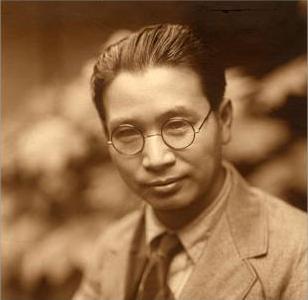Toyohiko Kagawa’s name appears over and over in Seventh-day Adventist magazines throughout the mid-twentieth century—there are at least thirty-five references to his name in the Adventist Digital Library. His story was first featured in Dr. John Harvey Kellogg’s Life Boat in 1929.
Life and Health reviewed Kagawa’s book, Love—The Law of Life (also translated The Law of Love and Life), in 1930. Likewise, Ministry reviewed his Meditations on the Cross in 1936. That same year he was hailed a distinguished guest on the campus of Union College.
Throughout the 1940s and 1950s, editors of the Review showed a marked interest in Kagawa’s activities in Japan and around the world, noting his tour of Europe, covering his remarks at the World Council of Churches in Chicago, and his influence with the Japanese government. For example, in September 1956 the Review, highlighting Kagawa’s work in post-war Japan, reported, “He called upon American religious bodies to send to Japan ‘fewer missionaries whose main concern is controversial doctrine’ and more who are ‘filled with the love of God and believe that the spirit of Christ is the core of faith.’”
When Keisaburo Hirano was baptized into the Seventh-day Adventist Church in Hawaii in 1964 at the age of 79, the Pacific Union Recorder reported that, although Hirano became a Christian and joined the Methodist Church in New York in the early 1920s, “later in California, in 1933, he was so interested in gospel work that he accompanied the late Dr. Toyohiko Kagawa on his itinerary.” With no explanation as to who Kagawa was, it was expected that readers would recognize the name and know about his American tours of the 1930s.
So, who was Toyohiko Kagawa?
One answer is that he was the leading Japanese Christian evangelist of his day. Britain’s The Bible and Our Times characterized him as the Japanese “Billy Graham.” Adventists certainly shared his evangelistic zeal, but Kagawa never joined the Seventh-day Adventist Church. His early education was in Presbyterian colleges, and debating doctrinal trivialities frustrated him.
Another answer is that Kagawa was a pacifist. He was imprisoned in 1940 for apologizing to the Republic of China for Japan’s occupation. Writing in the Signs of the Times in 1949, Merlin L. Neff quoted Kagawa as an authority on the spread of Christianity in Japan who claimed that the Japanese equated Christianity and Americans. In the context of the dropping of the atomic bombs on Japan in 1945 that destroyed countless homes and businesses, Kagawa claimed, “Only kindness can revive Christianity, not mere words or creeds. . . . The people need help, not words. Missionaries are no use now unless they help.”
But, perhaps most important to Kagawa’s heart was his role as social worker and reformer.
Communism’s only power is to diagnose some of the ills of disordered society. It has no cure. It creates only an infantile paralysis of the social order.
Born on July 10, 1888, Kagawa was the son of a Japanese nobleman and his concubine. After both of his parents died while he was still very young, Kagawa lived with extended family who were not kind to him. He was sent to parochial schools where he became a Christian. His encounter with Christ was no mere formality. It completely altered his life. Lacking another male role model, Kagawa determined to model his life after Jesus Christ alone.
I read in a book that a man called Christ went about doing good. It is very disconcerting to me that I am so easily satisfied with just going about.
Following the completion of theological school—which he worked his way through as his family completely cut him off after he converted to Christianity—Kagawa lived in the slums of Kobe for five years. One-on-one witnessing to the poorest of the poor, prostitutes, and criminals proved unsuccessful. Consequently, Kagawa accepted an opportunity for graduate study at Princeton University. Here he specialized in social work and labor organization. He returned to Japan to organize labor unions and a peace society, start schools, publish a newspaper, and successfully fight for universal manhood suffrage. He eventually founded at least 100 schools, reorganized Tokyo’s Bureau of Social Work, instituted agricultural reforms that improved productivity for impoverished farmers, and wrote more than sixty books. For his efforts he contracted tuberculosis and trachoma from the poor conditions he shared with his neighbors in Kobe, which permanently damaged his health. While fighting for suffrage he was imprisoned twice. His imprisonment for apologizing to the Republic of China for its occupation by Japan was a third sentence.
It seemed that everyone was attacking me – the Soviet Communists, the anarchists, the capitalists, the foul-mouthed literary critics, the sensationalist newspaper men, the Buddhist who could not compete with Christ, and those many Christians who profess Christ but believe in a Christianity which is sterile.
However, Kagawa was also rewarded for his activism. He was nominated for the Nobel Prize in Literature in 1947 and 1948, and the Nobel Peace Prize in 1954 and 1955. Posthumously, he was inducted in Japan’s Order of the Sacred Treasure, the nation’s second highest honor. Both the Episcopalian and the Presbyterian churches in the United States honor him in their liturgical calendars.
Japan has long been resistant to Christianity, and ultimately Kagawa’s social reforms had a more lasting impact in Japan than his preaching. His message of practical, hands-on, Christianity-in-action resonated with Seventh-day Adventists, attested by the coverage devoted to his work in Adventist publications. Kagawa’s message was not dry doctrine, but an active faith that raised people up to a better quality of life. Jesus’s ministry, melding the fulfillment of physical and spiritual needs, was exemplified in the life of this humble Japanese Christian.









